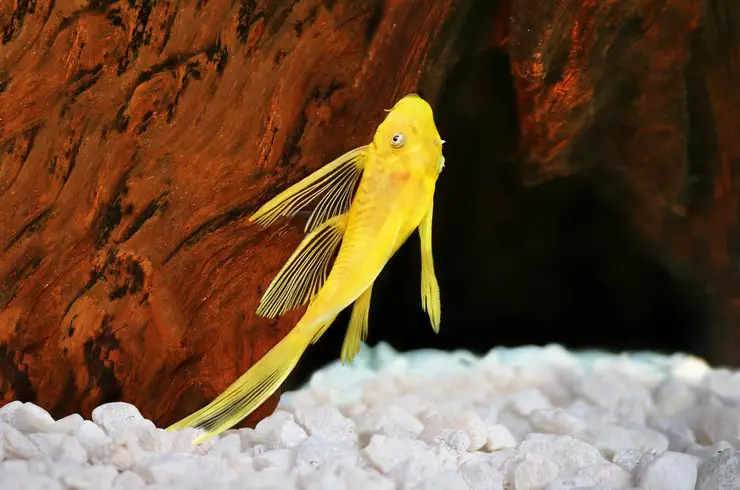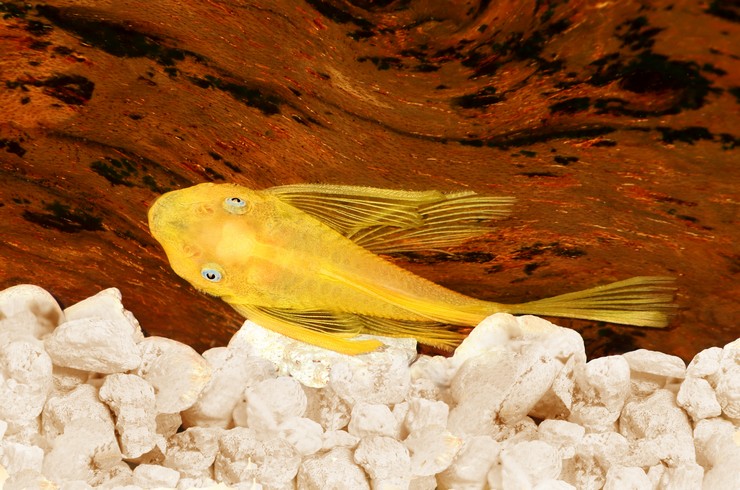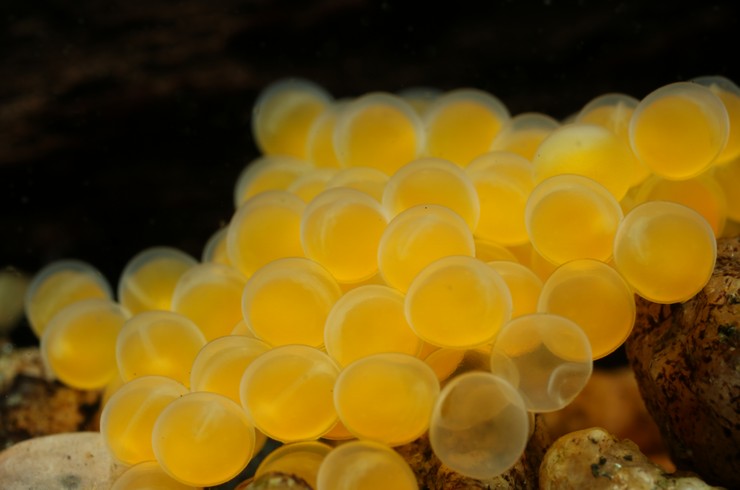Initially, all aquarium fish were caught in natural reservoirs, but later aquarists learned to breed many species at home or in production conditions. To create new forms that did not exist before in nature, breeders are taken to work, who select fish with unusual characteristics (non-standard color, long fins, etc.), and then fix them for many breeding. Some of the most popular is the so-called veil breeds of various types – fish with elongated fins. The veil form of the popular aquarium catfish – ancistrus – will be discussed in our article.
General information
Veil ancistrus is a selective form of the common ancistrus (Ancistrus Dolichopterus) from the Loricaria (Chain) catfish family. Differs in large, well-developed fins, which sway when moving, like a light veil. The name of the family comes from the word “Lori-ka”, as the armor of the legionaries of Ancient Rome was called. Ancistrus also have their own “armor” – rows of bony plates that cover the entire body. They serve to protect against enemies.
Fish prefer the lower layers of the aquarium and lead a predominantly crepuscular lifestyle. They are of great benefit in the aquarium, eating algae that form on glass, equipment, decorations.
Appearance
The body of the veil ancistrus is drop-flattened and covered with polygonal bone plates. The oral apparatus is modified into a “suction cup”, which allows the fish to stay on stones, snags, and scrape off algae.
Body-color can vary from light to dark gray. There are albino forms with a white body and red eyes. The color of the body serves as an indicator of the state of the catfish; in bad conditions, the fish turns pale. Gender dimorphism is pronounced but manifests itself only at the age of about 1 year. In males, special hooks grow on the head – tentacles, reaching a size of 15-20 mm, in females, they are small and located along the edges of the head. Catfish grow up to 15 cm in length.
The main distinguishing feature of veiled ancistrus is their fins. All of them, without exception, are well developed and can exceed the “standard” size by 3-4 times. It is especially interesting to watch the fish while moving when the fins are fully extended and sway in the stream of water.
Habitat
Veil ancistrus does not occur in nature and is a selective species bred by humans. The appearance in the natural environment of fish with similar fins probably leads to rapid death, since the catfish becomes more noticeable, and the fins themselves are easily injured.
Care and maintenance
A tropical aquarium with a volume of 50 liters or more is suitable for keeping ancistrus. Young catfish can be settled in groups, but adults are better in pairs or harems when there are several females per male. The fact is that with age, ancistrus become more territorial, and the likelihood of clashes with other males increases.
Sand or rounded pebbles can be used as soil. The stones mustn’t have sharp edges. It is imperative to put natural driftwood in the aquarium, which serves as a source of cellulose for veil ancistrus. Provide a variety of hiding places for your catfish to rest in. When choosing decorations, you need to pay attention to the absence of sharp surfaces that can damage the delicate fins of the catfish. Thickets of living plants are welcome.
Veil ancistrus love clean water with a high oxygen content, so you need to take care of a suitable filter and compressor. The lighting shouldn’t be very bright.
For a comfortable life of veiled ancistrus, do not forget about regular water changes – up to 20% of the volume of the aquarium.
Compatibility
You can keep veil ancistrus with almost any type of fish in the general aquarium. Small peaceful species (zebrafish, tetras, neons, barbs), and medium-sized cichlids, and even large aggressive fish that rarely touch ancistrus due to their “shell” and secretive lifestyle, are suitable for neighbors.
Ancistrus are also compatible with live plants, but care must be taken to feed the fish, otherwise, the delicate parts of some plants may suffer.
Feeding ancistrus veil
The basis of the diet of the veil ancistrus is algal fouling that appears on the walls of the aquarium or decorations when there is an excess of lighting. At the same time, the fish are very active in this matter and are excellent helpers to maintain cleanliness. Ancistrus do not disdain the remnants of food of other fish.
Often, many aquarists feed their pets with vegetation from their table: scalded lettuce, cabbage, or zucchini. Unfortunately, this way of eating in some cases can lead to contamination of the aquarium, especially if you do not remove the remnants of food. In addition, remember that the food must be nutritious and balanced.
For feeding veiled ancistrus, the following are perfect:
- Tetra Pleco Tablets are the staple food for all herbivorous bottom fish species. Bulky tablets quickly sink to the bottom and slowly soften, freeing the feed. They can be placed in a suitable place if necessary. The tablets contain a large number of spirulina algae, which helps the catfish to maintain health and provide additional vitality.
- Tetra Pleco Veggie Wafers are dense wafers specially designed to feed chain catfish. First of all, they are convenient for scraping with a suction cup. The food retains its shape for a long time, does not muddy the water in the aquarium. In the center of the plate is a concentrate of algae and zucchini for optimal digestion of herbivorous catfish.
- Tetra Pleco Spirulina Wafers is a complete catfish feed with algae concentrates enriched with Omega-3 acids that support the immune system of fish. The high fiber content contributes to comfortable digestion. Do not muddy the water.
You can feed catfish with tablets once a day before turning off the lights in the aquarium.
Reproduction and breeding
Breeding Veil Ancistrus is not difficult. Often, fish spawn on their own without human intervention. But for maximum preservation of the offspring, it is better to organize a separate container with a volume of 50-80 liters.
In the spawning aquarium, place ceramic or plastic tubes, stones, grottoes, or driftwood of the correct size. One male and a couple of females are usually planted for spawning. The stimulus is the addition of fresh hearth and a 2 ° C decrease in temperature.
The fertility of veiled ancistrus can reach up to 200 eggs. The caviar is large, orange. After spawning, the female must be removed, the male remains to look after the eggs. He fanns her with fins, removes dead eggs.
Incubation takes 4-7 days, then for a few more days the larvae feed on the yolk sac and hang on the slides. After hatching, the male fry must be deposited.
In an aquarium with fry, it is recommended to change 20% of the water daily, while small ancistrus will grow to the size of adults in six months, and after about 10 months they become pubertal and can participate in reproduction themselves.

